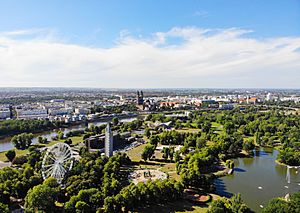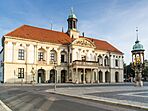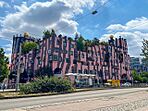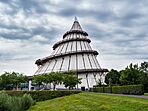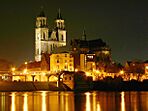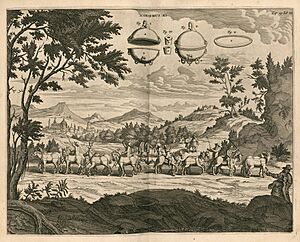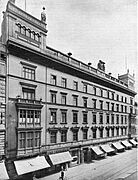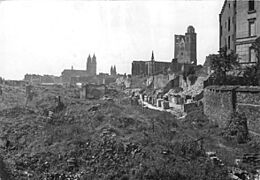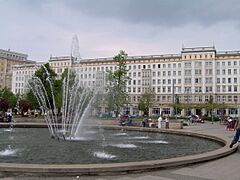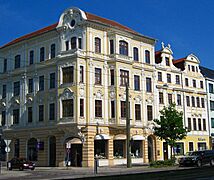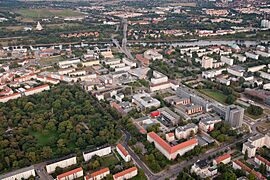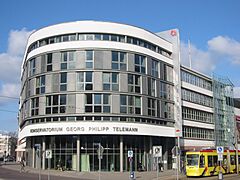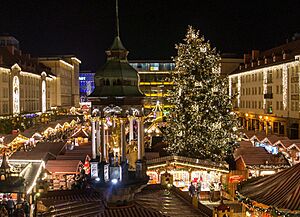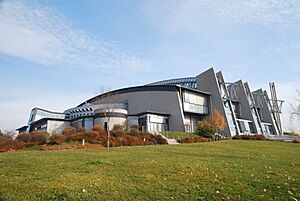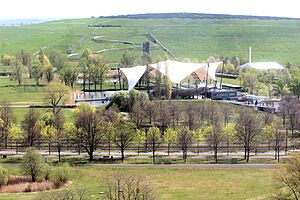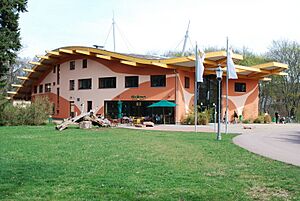Magdeburg facts for kids
Quick facts for kids
Magdeburg
Meideborg (Low German)
|
|||
|---|---|---|---|
|
From top, left to right:
Aerial view to a part of the city centre – Town Hall – "Green Citadel" – "Millennium Tower" – Magdeburg Cathedral at night – and panorama: city wall
|
|||
|
|||
| Lua error in Module:Location_map at line 530: Unable to find the specified location map definition: "Module:Location map/data/Germany Sachsen-Anhalt" does not exist. | |||
| Country | Germany | ||
| State | Saxony-Anhalt | ||
| District | Urban district | ||
| Subdivisions | 40 boroughs | ||
| Area | |||
| • Total | 201.03 km2 (77.62 sq mi) | ||
| Elevation | 43 m (141 ft) | ||
| Population
(2022-12-31)
|
|||
| • Total | 239,364 | ||
| • Density | 1,190.69/km2 (3,083.87/sq mi) | ||
| Time zone | UTC+01:00 (CET) | ||
| • Summer (DST) | UTC+02:00 (CEST) | ||
| Postal codes |
39104–39130
|
||
| Dialling codes | 0391 | ||
| Vehicle registration | MD | ||
| Website | magdeburg.de | ||
Magdeburg is a major city in Germany. It is the capital of the German state called Saxony-Anhalt. You can find Magdeburg right on the Elbe river.
This city has a long and interesting history. Otto I, the first Holy Roman Emperor, was buried here. His tomb is in the city's cathedral. Magdeburg was also famous for its special set of laws, known as Magdeburg rights. These laws were used in many other cities across Central and Eastern Europe. In the past, Magdeburg was one of Germany's biggest and richest cities. It was also an important member of the Hanseatic League, a powerful trading group.
One of the most famous people from Magdeburg was Otto von Guericke. He was a scientist known for his experiments with the Magdeburg hemispheres. These experiments showed the power of a vacuum.
Magdeburg has faced tough times in its history.
- In 1207, a big fire destroyed much of the city, including the old cathedral.
- In 1631, during the Thirty Years' War, the city was attacked. Many people lost their lives.
- During World War II, in 1945, parts of the city center were heavily bombed.
After World War II, Magdeburg was part of East Germany until 1990. Since then, the city has been rebuilt and many old buildings have been restored. In 2005, Magdeburg celebrated its 1,200th birthday!
Today, Magdeburg is an important city for transport and business. It sits on major highways, connecting different parts of Germany and Europe. Key industries here include machine building, healthcare, environmental technology, and logistics.
The city also has many fun cultural places. These include the Theater Magdeburg and the Museum of Cultural History. Magdeburg is also home to two universities: the Otto von Guericke University Magdeburg and the Magdeburg-Stendal University of Applied Sciences.
Contents
Magdeburg's Long History
Early Beginnings

Magdeburg was founded by Charlemagne in 805. Its name, "Magadoburg," likely means "mighty fortress." In 919, King Henry the Fowler built stronger defenses here. This was to protect the town from the Magyars and Slavs.
In 929, King Otto I gave the city to his wife, Edith. She loved Magdeburg and lived there often. When she died, she was buried in the crypt of a local abbey. Otto I visited Magdeburg many times. He also founded a convent there in 937. He was later buried in the cathedral.
In 968, the Archbishopric of Magdeburg was created. This was an important church region. The archbishops helped spread German culture and influence to lands east of the Elbe river.
In 1035, Magdeburg gained the right to hold trade fairs. This led to the famous Magdeburg rights. These laws helped cities grow and were used in many places across Central and Eastern Europe. By the 13th century, Magdeburg joined the Hanseatic League. It became one of the largest cities in the Holy Roman Empire, with over 20,000 people. The city traded with places like Flanders and countries near the North Sea.
The Reformation and War
By the late 1400s, the citizens of Magdeburg had gained a lot of independence from the archbishop. In 1497, a young Martin Luther went to school in Magdeburg. He learned about new religious ideas there. Later, in 1524, Luther visited Magdeburg again. His teachings helped the city move away from the Roman Catholic Church. Magdeburg quickly became a strong supporter of the Protestant Reformation.
Because it didn't follow the emperor's religious rules, the city was attacked in 1550–1551. But Magdeburg managed to stay independent. It became known as a center for Protestant ideas. It was even the first major city to print Martin Luther's writings.
In 1629, Magdeburg survived an attack during the Thirty Years' War. However, in 1631, imperial troops attacked again. The city was badly damaged, and many people died. After the war, only about 4,000 people remained.
Magdeburg recovered quickly, thanks to its mayor, Otto von Guericke. He was also a famous scientist. Just six years after the war, he did his famous Magdeburg hemispheres experiment. This experiment proved that a vacuum exists. This was a huge discovery for physics!
Modern Times
During the Napoleonic Wars, French troops took over Magdeburg in 1806. The city became part of the French-controlled Kingdom of Westphalia. After these wars, in 1815, Magdeburg became the capital of the new Prussian Province of Saxony.
In 1912, the old fortress walls were taken down. In 1908, the nearby town of Rothensee became part of Magdeburg.
During World War I, Polish leaders Józef Piłsudski and Kazimierz Sosnkowski were held prisoner in Magdeburg by Germany.
Magdeburg was heavily bombed during World War II. A big bombing raid in January 1945 destroyed much of the city center. Thousands of people died. After the war, the city was occupied by US troops, then by the Red Army. Many buildings that survived the war were later torn down.
From 1949 to 1990, Magdeburg was part of East Germany. After Germany became one country again in 1990, Magdeburg became the capital of Saxony-Anhalt. Since then, many new buildings have been built, and the economy has grown.
In 2005, Magdeburg celebrated its 1200th anniversary.
In 2013, the city was affected by floods from the Elbe river. Thousands of residents had to leave their homes.
Recently, the company Intel announced it will build its largest plant in Europe in Magdeburg by 2027.
Magdeburg Today
In 1990, Magdeburg became the capital of the new state of Saxony-Anhalt. Many parts of the city were rebuilt in a modern style. Its economy is growing quickly.
Magdeburg's Location and Areas
Magdeburg is a big city along the Elbe Cycle Route. Its total area is about 201 square kilometers.
City Districts
Magdeburg is divided into 40 Stadtteile (districts). Some of these, like Beyendorf-Sohlen, Pechau, and Randau-Calenberge, have a special status.
|
|
|
Weather in Magdeburg
Magdeburg has a mild climate. Winters are cool and sometimes damp. Summers are warm and can be a bit wet. It can get hot sometimes, with temperatures above 25°C on many days.
Thunderstorms happen about 20 times a year, mostly in spring and summer. Hail is rare and only occurs in spring and summer.
| Climate data for Magdeburg (1991–2020 normals) | |||||||||||||
|---|---|---|---|---|---|---|---|---|---|---|---|---|---|
| Month | Jan | Feb | Mar | Apr | May | Jun | Jul | Aug | Sep | Oct | Nov | Dec | Year |
| Record high °C (°F) | 16.5 (61.7) |
19.9 (67.8) |
25.1 (77.2) |
31.9 (89.4) |
32.8 (91.0) |
37.5 (99.5) |
38.2 (100.8) |
37.9 (100.2) |
33.6 (92.5) |
28.3 (82.9) |
21.1 (70.0) |
18.1 (64.6) |
38.2 (100.8) |
| Mean daily maximum °C (°F) | 4.0 (39.2) |
5.4 (41.7) |
9.6 (49.3) |
15.4 (59.7) |
19.6 (67.3) |
22.7 (72.9) |
25.0 (77.0) |
24.9 (76.8) |
20.2 (68.4) |
14.4 (57.9) |
8.3 (46.9) |
4.8 (40.6) |
14.5 (58.1) |
| Daily mean °C (°F) | 1.4 (34.5) |
2.1 (35.8) |
5.2 (41.4) |
9.9 (49.8) |
14.1 (57.4) |
17.2 (63.0) |
19.3 (66.7) |
19.0 (66.2) |
14.8 (58.6) |
10.0 (50.0) |
5.4 (41.7) |
2.3 (36.1) |
10.0 (50.0) |
| Mean daily minimum °C (°F) | −1.4 (29.5) |
−1.1 (30.0) |
1.1 (34.0) |
4.3 (39.7) |
8.3 (46.9) |
11.4 (52.5) |
13.6 (56.5) |
13.4 (56.1) |
10.0 (50.0) |
6.1 (43.0) |
2.5 (36.5) |
−0.3 (31.5) |
5.6 (42.1) |
| Record low °C (°F) | −23.8 (−10.8) |
−25.4 (−13.7) |
−17.6 (0.3) |
−6.9 (19.6) |
−2.9 (26.8) |
1.0 (33.8) |
5.4 (41.7) |
3.8 (38.8) |
0.0 (32.0) |
−6.7 (19.9) |
−13.3 (8.1) |
−22.6 (−8.7) |
−25.4 (−13.7) |
| Average precipitation mm (inches) | 38.3 (1.51) |
26.1 (1.03) |
34.9 (1.37) |
27.8 (1.09) |
56.1 (2.21) |
51.8 (2.04) |
60.9 (2.40) |
59.4 (2.34) |
43.3 (1.70) |
40.0 (1.57) |
36.8 (1.45) |
39.5 (1.56) |
515.8 (20.31) |
| Average precipitation days (≥ 1.0 mm) | 15.9 | 13.9 | 14.7 | 11.4 | 13.0 | 12.6 | 13.8 | 13.0 | 11.9 | 14.2 | 15.3 | 16.7 | 165.4 |
| Average snowy days (≥ 1.0 cm) | 8.4 | 6.3 | 2.1 | 0.2 | 0 | 0 | 0 | 0 | 0 | 0 | 1.0 | 5.0 | 23 |
| Average relative humidity (%) | 84.7 | 80.6 | 75.9 | 68.1 | 68.3 | 69.1 | 68.3 | 68.5 | 75.1 | 81.8 | 86.4 | 85.9 | 76.1 |
| Mean monthly sunshine hours | 59.7 | 80.8 | 126.9 | 189.5 | 228.8 | 235.4 | 230.6 | 215.7 | 162.7 | 116.0 | 59.7 | 49.1 | 1,754.8 |
| Source 1: NCEI | |||||||||||||
| Source 2: Infoclimat | |||||||||||||
Magdeburg's Population
| Historical population | ||
|---|---|---|
| Year | Pop. | ±% |
| 1400 | 30,000 | — |
| 1620 | 25,000 | −16.7% |
| 1825 | 36,647 | +46.6% |
| 1855 | 61,500 | +67.8% |
| 1871 | 84,401 | +37.2% |
| 1885 | 114,291 | +35.4% |
| 1890 | 202,234 | +76.9% |
| 1900 | 229,667 | +13.6% |
| 1910 | 279,629 | +21.8% |
| 1919 | 285,856 | +2.2% |
| 1925 | 293,959 | +2.8% |
| 1933 | 306,894 | +4.4% |
| 1939 | 336,838 | +9.8% |
| 1940 | 346,600 | +2.9% |
| 1945 | 225,030 | −35.1% |
| 1950 | 260,305 | +15.7% |
| 1956 | 259,320 | −0.4% |
| 1961 | 262,437 | +1.2% |
| 1966 | 267,817 | +2.1% |
| 1971 | 271,906 | +1.5% |
| 1976 | 279,430 | +2.8% |
| 1981 | 287,362 | +2.8% |
| 1986 | 288,975 | +0.6% |
| 1990 | 280,536 | −2.9% |
| 2001 | 229,755 | −18.1% |
| 2011 | 228,144 | −0.7% |
| 2022 | 241,517 | +5.9% |
| Population size may be affected by changes in administrative divisions. Source: | ||
In 2021, Magdeburg had about 237,000 people. Its population grew a lot in the late 1800s because of new factories. In 1885, there were 100,000 people. Just five years later, that number doubled!
Magdeburg had its largest population in 1940, with about 346,000 residents. After World War II, the population dropped. During the East Germany era, the city rebuilt its industries. It became an important industrial city.
In 1991, when Magdeburg became the capital of Saxony-Anhalt, its population was around 275,000. After Germany reunited, some people moved to West Germany. This caused the population to decline for a while. But since 2011, the number of residents has been stable, around 240,000.
Magdeburg is home to people from many different countries.
| Rank | Nationality | Population (2022) |
|---|---|---|
| 1 | 5,341 | |
| 2 | 4,893 | |
| 3 | 2,379 | |
| 4 | 1,431 | |
| 5 | 1,348 | |
| 6 | 1,253 | |
| 7 | 1,013 | |
| 8 | 947 | |
| 9 | 833 | |
| 10 | 674 |
Education in Magdeburg
Magdeburg has two main universities.
The Otto-von-Guericke University Magdeburg was founded in 1993. It is one of Germany's newer universities. About 13,000 students study here in nine different faculties. This university is known for its research, with many papers published in international journals.
The Magdeburg-Stendal University of Applied Sciences started in 1991. It offers about 30 study programs. There are over 130 professors. Around 4,500 students attend the Magdeburg campus.
Culture and Architecture
Fun Things to Do
Magdeburg has its own city theater, called Theater Magdeburg.
The city is famous for its Christmas market. About 1.5 million people visit it every year! Other popular events include the Stadtfest, Christopher Street Day, Elbe in Flames, and the Europafest Magdeburg. The autumn fair in Magdeburg is one of Germany's oldest folk festivals. It started in 1010.
Event Places
- Altes Theater am Jerichower Platz: An old theater used for parties and big meetings.
- AMO: A building for culture and conferences.
- Buttergasse: A nightclub near the city center.
- Concert hall Georg Philipp Telemann: Located at "Kloster unser lieben Frauen."
- Factory: A former factory building where German and international music artists perform.
- Festung Mark: Part of the old city walls, now used for parties and events.
- Feuerwache: A former fire station, now used for events.
- GETEC Arena: The biggest multi-purpose hall in Saxony-Anhalt. It's home to the handball team SC Magdeburg.
- halber85: A place for conventions, parties, and conferences.
- Kunstkantine: A factory cafeteria that hosts monthly electro-music parties.
- MDCC-Arena: The home stadium of 1. FC Magdeburg (soccer team).
- Messe Magdeburg: The official trade fair site.
- Prinzzclub: A nightclub on Halberstädter Straße.
- Seebühne: A lake-stage in Elbauenpark.
- Stadthalle: A concert hall.
- Studentenclub Baracke: A nightclub especially for students.
- Tessenow Loft: Used for conventions, parties, and conferences.
Museums to Explore
- Magdeburg Museum of Cultural History
- Otto-von-Guericke-Museum Lukasklause
- Jahrtausendturm (Millennium Tower)
- Magdeburg Museum of Nature
- Magdeburg Museum of Technology
- Art Museum in the Monastery of Our Lady
- Magdeburg Circus Museum
- Magdeburg Hairdressing Museum
- Steamboat Württemberg - a museum ship
Amazing Architecture
The Grand Cathedral
One of Magdeburg's most stunning buildings is the Lutheran Cathedral of Saints Catherine and Maurice. It stands 104 meters tall, making it the tallest church in eastern Germany. The cathedral has beautiful and unique sculptures. Look for the "Twelve Virgins" at the Northern Gate. You can also see statues of Otto I the Great and his wife Editha.
The first church here was built in 937. It was called St. Maurice. Emperor Otto I the Great was buried here in 973. This first church burned down in 1207. Its foundations were found again in 2003.
Building the new cathedral took 300 years! It was the first Gothic church in Germany. The tall steeples were finished in 1520.
The cathedral was one of the few buildings to survive the Thirty Years' War. It was damaged in World War II but was rebuilt by 1955.
The area in front of the cathedral was once home to an imperial palace. This palace was destroyed in the 1207 fire. Its stones were used to build the cathedral.
Other Cool Sights
- Unser Lieben Frauen Monastery: Built in the 11th century, it includes the church of St. Mary. Today, it's a museum for Modern Art.
- The Magdeburger Reiter' ("Magdeburg Rider", 1240): This is the first free-standing horse statue north of the Alps. It probably shows Emperor Otto I.
- City Hall: The current building was built in 1698. It has a Renaissance style. It was reopened in 2005 after being renovated.
- Landtag: This is where the government of Saxony-Anhalt meets. It has a beautiful Baroque front from 1724.
- Monuments: You can see statues of famous people like Otto von Guericke and Friedrich Wilhelm von Steuben.
- Rotehorn-Park: A lovely park in the city.
- Elbauenpark: This park has the tallest wooden structure in Germany.
- St. Sebastian's Cathedral: The main church for Catholics in Magdeburg.
- St. John Church (Johanniskirche): Another important church.
- The Gruson-Gewächshäuser: A botanical garden inside a greenhouse complex.
- The Magdeburg Water Bridge: Europe's longest water bridge!
- "Die Grüne Zitadelle": Also known as The Green Citadel of Magdeburg. It's a large, pink building with a modern design by Friedensreich Hundertwasser. It was finished in 2005.
- Jerusalem Bridge: An interesting bridge in the city.
- Zoo Magdeburg: A great place to see animals.
- St. Petri Church: Features beautiful stained glass.
Sports in Magdeburg
Magdeburg has a proud history of sports. The football club 1. FC Magdeburg plays in the 2. Bundesliga, which is Germany's second-highest football league. They are the only East German football club to have won the UEFA Cup Winners' Cup.
The city also has a very successful handball team, SC Magdeburg. They have won many national and international titles. These include the Handball-Bundesliga, EHF Champions League, and the IHF Men's Super Globe.
The sport of discus was "re-discovered" in Magdeburg in the 1870s. This happened thanks to Christian Georg Kohlrausch, a gymnastics teacher.
Magdeburg's Sister Cities
Magdeburg is connected with other cities around the world. These are called "twin towns" or "sister cities":
 Sarajevo, Bosnia and Herzegovina (1977)
Sarajevo, Bosnia and Herzegovina (1977) Braunschweig, Germany (1987)
Braunschweig, Germany (1987) Nashville, United States (2003)
Nashville, United States (2003) Zaporizhzhia, Ukraine (2008)
Zaporizhzhia, Ukraine (2008) Radom, Poland (2008)
Radom, Poland (2008) Harbin, China (2008)
Harbin, China (2008) Le Havre, France (2011)
Le Havre, France (2011)
Famous People from Magdeburg
- Otto von Guericke (1602–1686): A mayor and scientist. He invented the Magdeburg hemispheres. The Otto von Guericke University Magdeburg is named after him.
- Georg Philipp Telemann (1681–1767): A very famous composer.
- Friedrich Wilhelm von Steuben (1730–1794): An American patriot who helped train the Continental Army.
- Christian Georg Kohlrausch (1851–1934): A gymnastics teacher who helped bring back the discus throw sport.
- Erich Ollenhauer (1901–1963): A leader of the Social Democratic Party of Germany.
- Ernst Reuter (1889–1953): He was Mayor of Magdeburg and later Mayor of West Berlin.
- Christiane Nüsslein-Volhard (born 1942): A biologist who won the Nobel Prize in 1995.
- Stefan Kretzschmar (born 1973): A famous handball player.
- Marcel Schmelzer (born 1988): A well-known footballer.
- Gustav Schäfer (1988-): The drummer for the band Tokio Hotel.
Images for kids
-
Elbe river in Magdeburg
See also
 In Spanish: Magdeburgo para niños
In Spanish: Magdeburgo para niños


